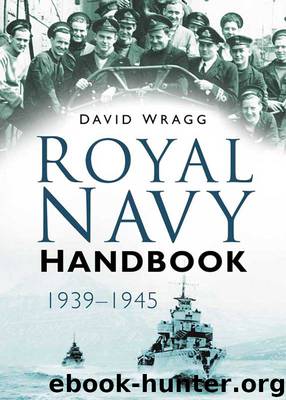Royal Navy Handbook 1939-1945 by David Wragg

Author:David Wragg
Language: eng
Format: epub
ISBN: 9780750954280
Publisher: The History Press
Published: 2013-08-30T16:00:00+00:00
Surface ships
246
Shore-based aircraft (other than bombing raids)
245
Bombing raids
61
Accidents and scuttling
57
Shared between surface ships and aircraft
50
Ship-borne aircraft
43
Unknown causes
29
Mines
26
Submarines
21
Russian advance
7
Other German losses included 2 battleships, 2 battlecruisers, 3 ‘pocket’ battleships, 2 old battleships, the single uncompleted aircraft carrier, 8 cruisers, 101 destroyers and torpedo boats, 7 armed merchant cruisers used as commerce raiders, 23 minelayers, 25 smaller escort vessels, 282 minesweepers, 64 mine destructor boats or sperrbrecher, 146 E-boats (known to the Germans as S-boats), 860 miscellaneous craft and as many as 600 ferry barges, mainly in the surface follow-up to the invasion of Crete. The Italians lost a battleship, although two more were knocked out at Taranto, 14 cruisers, 85 destroyers and torpedo boats, 3 minelayers, 84 submarines, 35 minesweepers, 72 mis-cellaneous craft and about 60 barges.
BATTLESHIPS
Queen Elizabeth Class
Queen Elizabeth, Warspite, Valiant, Barham, Malaya
Built during the First World War but modernisation started before the Second World War, largely driven by the fact that new capital ships could not be laid down before 1 January 1937. On the outbreak of war, Warspite had been completely reconstructed, while work on Queen Elizabeth and Valiant was in hand, but Malaya and Barham had been only partly reconstructed. Attention was given to improving underwater protection and AA armament, but the main armament was also improved, using modern shells so that the range of the 15in guns went from 23,400 yards to 32,200 yards. Nevertheless, there were limitations on what could be achieved: while armour plating was improved by laying 2.5in armour on top of the original 1in, but this was, of course, far inferior to a single sheet of 3.5in had it been possible to retrofit this. Over the magazines, doubtless with the lessons of Jutland in mind, armour plating was 4in over the original 1in. Warspite was the first to receive attention, with torpedo bulges fitted as early as 1926, while funnels were merged into one to stop back draughts carrying gases to the bridge. There was an almost ten-fold increase in pump capacity to handle fires or flooding. Torpedo tubes were removed as part of the modernisation, which also saw a catapult added, plus accommodation for two Supermarine Walrus aircraft. Machinery was also improved, with the upgrading of the geared turbines, and as a result the maximum range increased from 4,400 miles at 10 knots to 13,500 miles. The number of boilers was reduced from twenty-four to eight of a much-improved design.
Barham torpedoed and sunk off Libya, 25 November 1941.
Displacement: The 1940 standard saw these ships displace 36,450 tons full load.
Armament: 8 × 15in; 20 × 4.5in HA guns; 32 × 2pdr HA guns in four mountings; 16 × 0.5in guns in four mountings.
Maximum speed: 25 knots.
Royal Sovereign Class
Royal Sovereign, Resolution, Revenge, Royal Oak, Ramillies (all 1916–17)
Built during the First World War, but their smaller size meant that less could be done to update them. Ramillies had underwater bulges fitted and in 1917 it was decided to extend this protection to the other four ships of the class. As war approached, efforts were
Download
This site does not store any files on its server. We only index and link to content provided by other sites. Please contact the content providers to delete copyright contents if any and email us, we'll remove relevant links or contents immediately.
| Automotive | Engineering |
| Transportation |
Whiskies Galore by Ian Buxton(41529)
Introduction to Aircraft Design (Cambridge Aerospace Series) by John P. Fielding(32888)
Small Unmanned Fixed-wing Aircraft Design by Andrew J. Keane Andras Sobester James P. Scanlan & András Sóbester & James P. Scanlan(32573)
Craft Beer for the Homebrewer by Michael Agnew(17932)
Turbulence by E. J. Noyes(7700)
The Complete Stick Figure Physics Tutorials by Allen Sarah(7137)
Kaplan MCAT General Chemistry Review by Kaplan(6595)
The Thirst by Nesbo Jo(6435)
Bad Blood by John Carreyrou(6274)
Modelling of Convective Heat and Mass Transfer in Rotating Flows by Igor V. Shevchuk(6222)
Learning SQL by Alan Beaulieu(6035)
Weapons of Math Destruction by Cathy O'Neil(5827)
Man-made Catastrophes and Risk Information Concealment by Dmitry Chernov & Didier Sornette(5645)
Digital Minimalism by Cal Newport;(5389)
Life 3.0: Being Human in the Age of Artificial Intelligence by Tegmark Max(5184)
iGen by Jean M. Twenge(5161)
Secrets of Antigravity Propulsion: Tesla, UFOs, and Classified Aerospace Technology by Ph.D. Paul A. Laviolette(4989)
Design of Trajectory Optimization Approach for Space Maneuver Vehicle Skip Entry Problems by Runqi Chai & Al Savvaris & Antonios Tsourdos & Senchun Chai(4839)
Electronic Devices & Circuits by Jacob Millman & Christos C. Halkias(4747)
